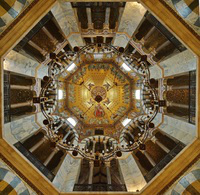Speaker
Description
With precise determinations of the lifetime and angular correlations in the decay of the neutron, we can characterize the left-handed nature of the weak interaction and search for the influence of new interactions. The Nab experiment's primary goal is to determine the ratio of the hadronic axial-vector and vector form factors with a goal sensitivity of $\delta\lambda/\lambda\sim0.03\%$, which will allow for a competitive test of unitarity of the Cabibbo Kobayashi Maskawa quark mixing matrix. The parameter $\lambda$ will be extracted from the correlation between the antineutrino and electron emitted in the decay, determined from the three-body kinematics using the momentum of the proton and the electron energy. In addition, Nab will search for a distortion of the energy spectrum of the electron caused by the Fierz interference term at the level of $\delta b \sim 3\times10^{-3}$, which could indicate the presence of Beyond Standard Model scalar or tensor currents. Nab implements a 7 m tall asymmetric magnetic spectrometer to collect the charged decay particles with 4$\pi$ acceptance, with a field expansion in the long arm to determine the proton's momentum from its time of flight with sub ns average precision. The proton and electron are detected in coincidence by a detection system with fast timing ($<$50 ns) and good energy resolution ($\sim$3 keV FWHM at 30 keV) based on thick, large area, segmented silicon detectors. The spectrometer is currently commissioning at the Fundamental Neutron Physics Beamline at the Spallation Neutron Source and final development of the fully instrumented detection system is underway. An overview of Nab's approach to achieve these science goals and early demonstrations of the capabilities of the experiment will be presented.




